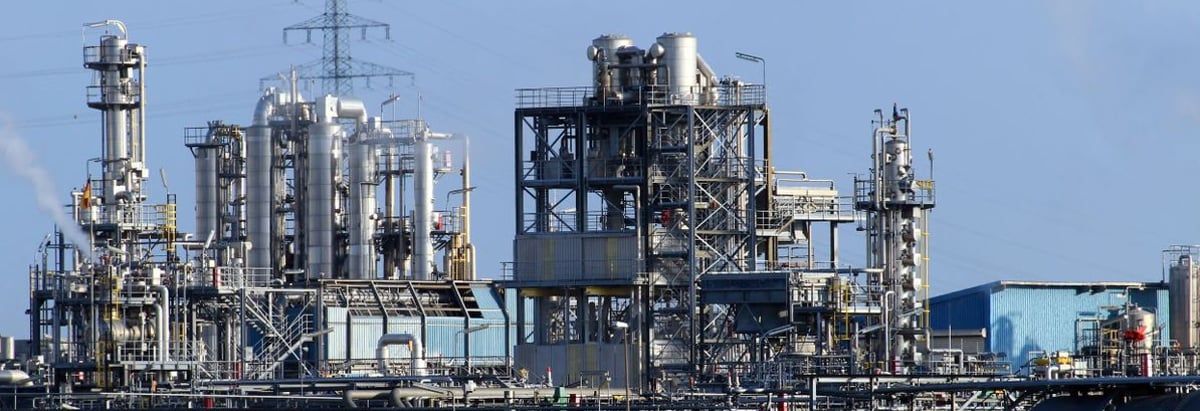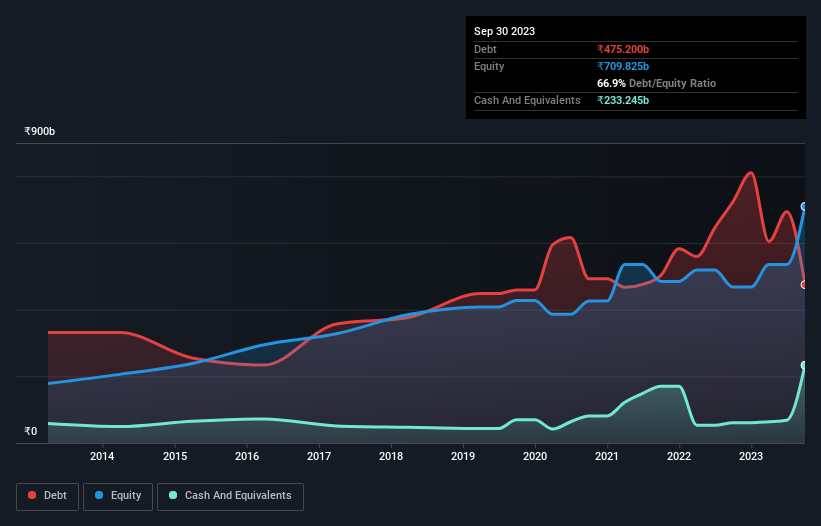
Warren Buffett famously said, 'Volatility is far from synonymous with risk.' It's only natural to consider a company's balance sheet when you examine how risky it is, since debt is often involved when a business collapses. We note that Bharat Petroleum Corporation Limited (NSE:BPCL) does have debt on its balance sheet. But the real question is whether this debt is making the company risky.
When Is Debt A Problem?
Debt and other liabilities become risky for a business when it cannot easily fulfill those obligations, either with free cash flow or by raising capital at an attractive price. Part and parcel of capitalism is the process of 'creative destruction' where failed businesses are mercilessly liquidated by their bankers. However, a more usual (but still expensive) situation is where a company must dilute shareholders at a cheap share price simply to get debt under control. Having said that, the most common situation is where a company manages its debt reasonably well - and to its own advantage. The first step when considering a company's debt levels is to consider its cash and debt together.
Check out our latest analysis for Bharat Petroleum
What Is Bharat Petroleum's Debt?
As you can see below, Bharat Petroleum had ₹475.2b of debt at September 2023, down from ₹723.7b a year prior. However, it also had ₹233.2b in cash, and so its net debt is ₹242.0b.

How Healthy Is Bharat Petroleum's Balance Sheet?
The latest balance sheet data shows that Bharat Petroleum had liabilities of ₹886.8b due within a year, and liabilities of ₹513.4b falling due after that. Offsetting these obligations, it had cash of ₹233.2b as well as receivables valued at ₹58.9b due within 12 months. So its liabilities total ₹1.11t more than the combination of its cash and short-term receivables.
Given this deficit is actually higher than the company's massive market capitalization of ₹1.02t, we think shareholders really should watch Bharat Petroleum's debt levels, like a parent watching their child ride a bike for the first time. In the scenario where the company had to clean up its balance sheet quickly, it seems likely shareholders would suffer extensive dilution.
We measure a company's debt load relative to its earnings power by looking at its net debt divided by its earnings before interest, tax, depreciation, and amortization (EBITDA) and by calculating how easily its earnings before interest and tax (EBIT) cover its interest expense (interest cover). Thus we consider debt relative to earnings both with and without depreciation and amortization expenses.
Bharat Petroleum's net debt is only 0.56 times its EBITDA. And its EBIT covers its interest expense a whopping 12.2 times over. So we're pretty relaxed about its super-conservative use of debt. Even more impressive was the fact that Bharat Petroleum grew its EBIT by 1,412% over twelve months. That boost will make it even easier to pay down debt going forward. There's no doubt that we learn most about debt from the balance sheet. But it is future earnings, more than anything, that will determine Bharat Petroleum's ability to maintain a healthy balance sheet going forward. So if you're focused on the future you can check out this free report showing analyst profit forecasts.
Finally, a company can only pay off debt with cold hard cash, not accounting profits. So we always check how much of that EBIT is translated into free cash flow. Over the last three years, Bharat Petroleum recorded free cash flow worth a fulsome 85% of its EBIT, which is stronger than we'd usually expect. That positions it well to pay down debt if desirable to do so.
Our View
The good news is that Bharat Petroleum's demonstrated ability to cover its interest expense with its EBIT delights us like a fluffy puppy does a toddler. But we must concede we find its level of total liabilities has the opposite effect. When we consider the range of factors above, it looks like Bharat Petroleum is pretty sensible with its use of debt. That means they are taking on a bit more risk, in the hope of boosting shareholder returns. The balance sheet is clearly the area to focus on when you are analysing debt. However, not all investment risk resides within the balance sheet - far from it. Case in point: We've spotted 2 warning signs for Bharat Petroleum you should be aware of, and 1 of them is significant.
If, after all that, you're more interested in a fast growing company with a rock-solid balance sheet, then check out our list of net cash growth stocks without delay.
Valuation is complex, but we're here to simplify it.
Discover if Bharat Petroleum might be undervalued or overvalued with our detailed analysis, featuring fair value estimates, potential risks, dividends, insider trades, and its financial condition.
Access Free AnalysisHave feedback on this article? Concerned about the content? Get in touch with us directly. Alternatively, email editorial-team (at) simplywallst.com.
This article by Simply Wall St is general in nature. We provide commentary based on historical data and analyst forecasts only using an unbiased methodology and our articles are not intended to be financial advice. It does not constitute a recommendation to buy or sell any stock, and does not take account of your objectives, or your financial situation. We aim to bring you long-term focused analysis driven by fundamental data. Note that our analysis may not factor in the latest price-sensitive company announcements or qualitative material. Simply Wall St has no position in any stocks mentioned.
About NSEI:BPCL
Bharat Petroleum
Primarily engages in refining crude oil and marketing petroleum products in India and internationally.
Established dividend payer with adequate balance sheet.
Similar Companies
Market Insights
Community Narratives





